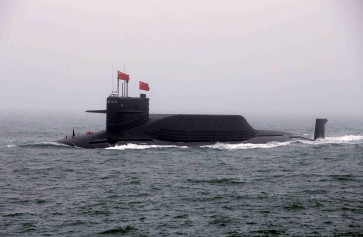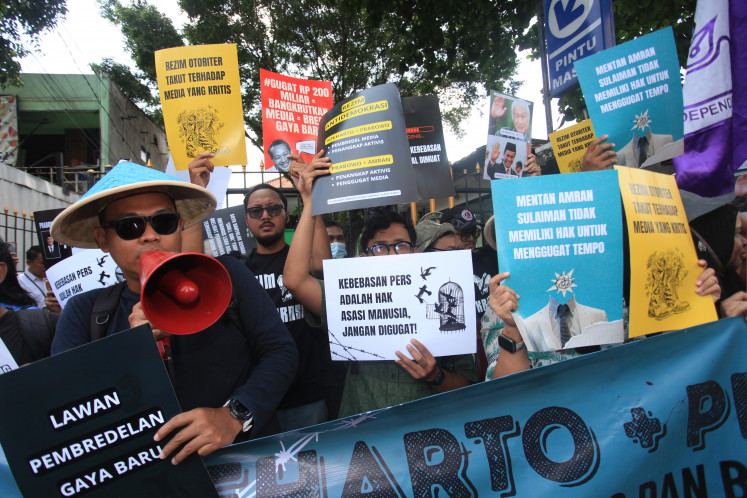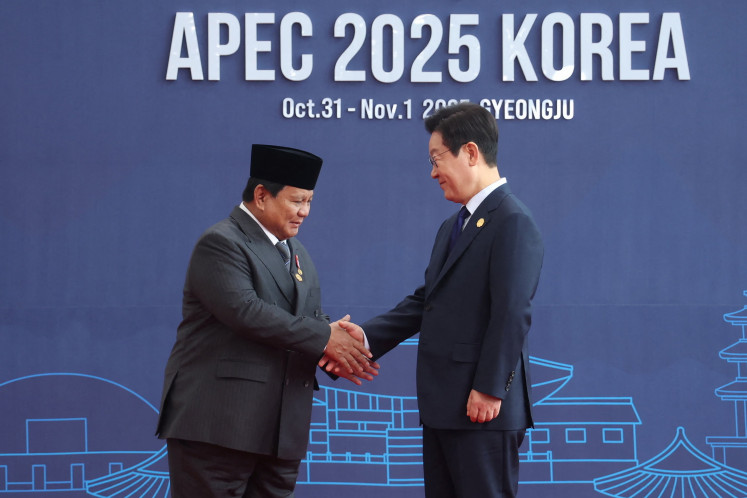Popular Reads
Top Results
Can't find what you're looking for?
View all search resultsPopular Reads
Top Results
Can't find what you're looking for?
View all search resultsRI SING 50: RI-S’pore defense ties: Why size doesn’t matter
Working together: Republic of Singapore Air Force F16s (center) and Indonesian Air Force F16s (left and right) conduct work-up training for a combined flypast, in airspaces between Singapore and Sumatra on Aug
Change text size
Gift Premium Articles
to Anyone
W
span class="caption">Working together: Republic of Singapore Air Force F16s (center) and Indonesian Air Force F16s (left and right) conduct work-up training for a combined flypast, in airspaces between Singapore and Sumatra on Aug. 30.(Reuters/Edgar Su)
Strategic uncertainties mark the 50th anniversary of Indonesian-Singapore relations this week. The challenges of terrorism, nuclear proliferation, and maritime piracy of late emerged alongside geopolitical repercussions of great power rivalry in Asia.
Similar to 50 years ago, the two countries are once again facing the prospect of a destabilizing and less secure Southeast Asia. As they face these and other challenges in the next 50 years, regional security and stability should become the raison d’être of Indonesia-Singapore defense ties.
In the Shangri-La Dialogue (SLD) this year, Singapore’s Defense Minister Dr. Ng Eng Hen reminded delegates of the importance of security and stability as preconditions to flourishing trade. For trade was and still is key to Southeast Asia’s continued economic growth and prosperity.
Singapore’s role as a regional maritime hub, and Indonesia’s aspirations to become one, rests on the assumption that Southeast Asia remains secure and stable as a conduit of trade between the Indian and Pacific Oceans.
In 1966-67, however, the strategic environment was bleak. Then Indonesia and Singapore were still reeling from traumatic crises of their lifetimes amid a politically turbulent Southeast Asia. Singapore had just recovered from Indonesia’s bellicose Konfrontasi (Confrontation) policy and the separation from Malaysia. Meanwhile, the rise to power of anti-communist Gen. Soeharto in Indonesia coincided with a violent dissolution of one of the world’s largest communist parties.
Boosting military skills: Indonesian and Singaporean sailors take part in a joint naval exercise in Jakarta, on Aug. 23, 2006. The 10-day 19th Indonesia-Singapore naval joint exercise, named Exercise Eagle-19, aimed at increasing the military effectiveness of both countries.(AFP/Bay Ismoyo)
All this occurred while the American war in Vietnam was raging and the fear of communist subversions and insurgencies was spreading throughout Southeast Asia. Moreover, the rivalry between China, the then Soviet Union and the United States to seek Southeast Asian clientele and proxies threatened to drag the region deeper into the Cold War.
In the face of such adversity, Indonesia and Singapore established ASEAN with Malaysia, the Philippines and Thailand in August 1967. They believed that a conflict-ridden Southeast Asia would deny their countries the opportunity to concentrate on domestic political stability and economic development. ASEAN thus became the standard-bearer of regional stability and security.
Common stake in regional security and stability, as ASEAN symbolizes, aligned Indonesian and Singaporean strategic perceptions. It ushered a golden period of Indonesia-Singapore defense relations. The two countries conduct regular joint naval exercises and coordinated patrols since 1974, followed similarly by their army and air force counterparts.
The proliferation of these activities since 2010s made Singapore Indonesia’s closest bilateral defense cooperation partner in ASEAN. That defense cooperation has so matured between Southeast Asia’s largest and smallest countries is a testament that a difference in size hardly matters when the two countries can realize what is at stake.
It’s necessary, however, that bilateral defense ties should find a self-sustaining momentum by making its dividends reverberate across Southeast Asia and possibly, beyond.
First, Indonesia and Singapore as founding members of ASEAN must see the grouping continues to find relevance. The widening scope of ASEAN plus activities in defense should directly contribute to the lessening of regional suspicions and tensions. For example, growing number of submarine operators in Southeast Asia should motivate Indonesia and Singapore to co-organize a working group under the ASEAN Defense Ministers’ Meeting on submarine safety and rescue. This is important since current initiatives on regional submarine cooperation have largely proceeded outside ASEAN purview, such as under the Western Pacific Naval Symposium and the US Pacific Command.
Second, a disaster-prone Southeast Asia is an opportunity for Indonesia and Singapore to mobilize regional defense contribution in disaster response and mitigation. The two countries should improve cooperation between the Jakarta-based ASEAN Humanitarian Assistance (AHA) Center and Singapore’s Regional HADR Coordination Center (RHCC) to find areas of complementarity. For instance, they can establish shared regional protocols specific to defense and military contexts in disaster response and management.
Third, industrial and technological cooperation seems an underdeveloped area of bilateral defense cooperation. Although Singapore is far ahead than Indonesia in developing unmanned technology or drones, the appetite and scope of demand from the latter for such technology might provide an incentive for joint research, design, and development with the former.
Friendship: A Singaporean (left) and Indonesian sailor (right) pose during a joint naval exercise on board a ship at a port in Jakarta, Aug. 23, 2006. The 10-day 19th Indonesia-Singapore naval joint exercise, named Exercise Eagle-19, aimed at increasing the military effectiveness of both countries.(AFP/Bay Ismoyo)
This cooperation can follow the model of Indonesia-South Korea KFX fighter jet program in which Indonesia is committed to purchase a substantial number of platforms in exchange for technology transfer as well as some ownership and copyright of the product. If successful, the two countries can market this product to third parties, possibly starting from ASEAN.
Fourth, Indonesia and Singapore could co-host regional cyber and electronic warfare symposiums. As their militaries modernize, so too their reliance on information and communications technology. The network-centric nature of modern military operations will intensify the use of sensor nodes with data-links as a force multiplier. These symposiums can inform participants on addressing areas of vulnerability concomitant with increased reliance on sensor-based technology.
All this may sound rosy. Just because defense ties are maturing, they hardly mean Indonesia and Singapore will cease finding themselves at cross-purposes and in prickly disputes. Historical baggage from Konfrontasi era may weigh cooperation down. The politics of jealousy from a feeling of inferiority complex may tempt them into a political posturing to outpace, outmatch, and outcompete one other.
National self-entitlement and self-aggrandizement, epitomized in the self-styled “big brother” of ASEAN, can produce patronizing and condescending attitude inconsistent with the spirit of equal cooperation. Domestic political expediency by appealing to popular emotions and to rally round the flag may raise unnecessary diplomatic kerfuffle.
All of the above already occurred before almost to the point of breakdown, as in Indonesia’s vitriolic reaction to Singapore’s execution of two Indonesian Marines in 1968. Yet, little did Indonesia and Singapore realize then that Konfrontasi and its hangover would become the exception to the rule.
The ghosts of Konfrontasi will never disappear and yet nor will they become the norm. Our attention and confidence should rest instead on how many times the relationship recovers in leaps and bounds from every past shock and crisis.
_____________________________
The writer is an Indonesian LPDP Presidential PhD scholar with the Strategic and Defense Studies Centre at the Australian National University.












